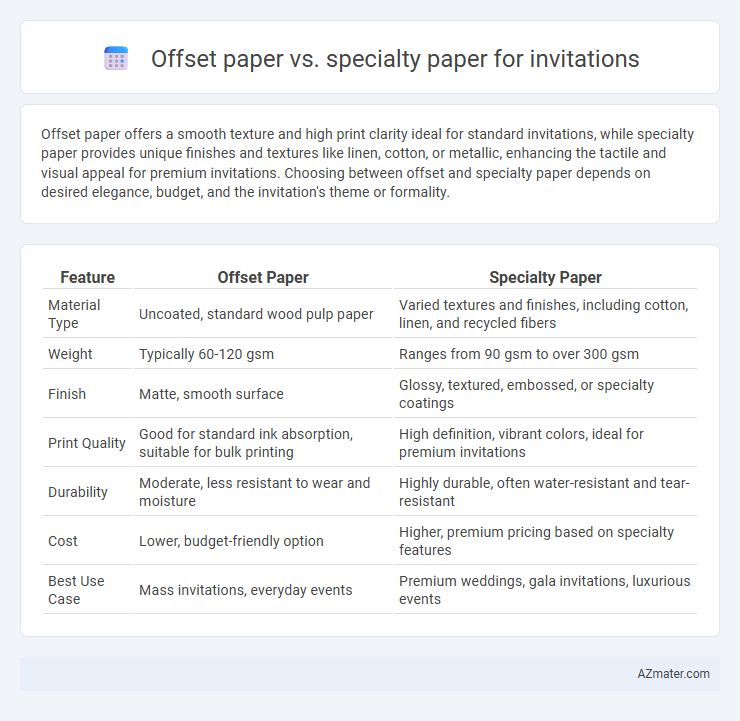Offset paper offers a smooth texture and high print clarity ideal for standard invitations, while specialty paper provides unique finishes and textures like linen, cotton, or metallic, enhancing the tactile and visual appeal for premium invitations. Choosing between offset and specialty paper depends on desired elegance, budget, and the invitation's theme or formality.
Table of Comparison
| Feature | Offset Paper | Specialty Paper |
|---|---|---|
| Material Type | Uncoated, standard wood pulp paper | Varied textures and finishes, including cotton, linen, and recycled fibers |
| Weight | Typically 60-120 gsm | Ranges from 90 gsm to over 300 gsm |
| Finish | Matte, smooth surface | Glossy, textured, embossed, or specialty coatings |
| Print Quality | Good for standard ink absorption, suitable for bulk printing | High definition, vibrant colors, ideal for premium invitations |
| Durability | Moderate, less resistant to wear and moisture | Highly durable, often water-resistant and tear-resistant |
| Cost | Lower, budget-friendly option | Higher, premium pricing based on specialty features |
| Best Use Case | Mass invitations, everyday events | Premium weddings, gala invitations, luxurious events |
Introduction to Invitation Paper Types
Offset paper offers smooth texture and excellent print quality, making it ideal for mass-produced invitations needing sharp text and vibrant colors. Specialty paper includes textured, handmade, or metallic finishes that enhance the tactile experience and aesthetic appeal, often used for luxury or personalized invitations. Understanding the differences between offset and specialty paper helps in selecting the best option for the desired invitation style and event formality.
What is Offset Paper?
Offset paper is a high-quality, smooth-textured paper designed for offset printing, offering excellent ink absorption and sharp image reproduction ideal for invitations. It typically features a consistent weight and brightness, ensuring vibrant colors and crisp text. Compared to specialty paper, offset paper provides a cost-effective solution with reliable performance for producing elegant, professional invitations.
What is Specialty Paper?
Specialty paper differs from offset paper by offering unique textures, finishes, and weights tailored for invitations, enhancing the tactile and visual appeal. Unlike standard offset paper, specialty paper includes options like metallic, pearlized, or handmade stocks that elevate the invitation's elegance and customization. Selecting specialty paper for invitations ensures a distinctive, luxurious presentation that standard offset paper cannot achieve.
Key Differences Between Offset and Specialty Papers
Offset paper, commonly used for high-volume printing, features smooth surfaces and consistent brightness optimized for ink absorption and cost-efficiency. Specialty paper, designed for invitations, offers unique textures, finishes, and weights that enhance tactile appeal and visual impact. Key differences include print quality versatility, texture variety, and customization options that make specialty paper ideal for premium or personalized invitations compared to the standard offset paper.
Print Quality: Offset vs. Specialty Paper
Offset paper offers consistent print quality with high resolution and sharp detail, ideal for bulk invitations requiring vibrant colors and crisp images. Specialty paper, such as textured or handmade varieties, enhances tactile appeal and can create unique visual effects but may slightly compromise ink absorption and print sharpness. Choosing between offset and specialty paper depends on the desired balance between print precision and customized aesthetics for invitation designs.
Texture and Appearance Comparison
Offset paper offers a smooth, consistent texture with a matte finish, ideal for clear, sharp printing and a professional look on invitations. Specialty paper provides unique textures such as linen, embossed, or metallic finishes, creating a tactile and visually striking appearance that enhances the invitation's elegance and uniqueness. The choice between offset and specialty paper significantly impacts the tactile experience and aesthetic appeal, influencing the overall impression of the invitation.
Cost Analysis: Offset vs. Specialty Paper
Offset paper generally offers a lower cost per sheet compared to specialty paper, making it a budget-friendly option for bulk invitation printing. Specialty papers, including textured, metallic, or handmade varieties, carry higher material and production expenses due to their unique finishes and limited availability. Evaluating the budget constraints alongside the desired visual impact helps determine whether the investment in specialty paper justifies its premium price over standard offset paper.
Suitability for Various Invitation Styles
Offset paper offers a smooth, consistent surface ideal for classic and formal invitation styles, delivering sharp text and vibrant colors with cost-effective printing. Specialty paper includes textured, handmade, or metallic finishes that enhance the tactile experience and visual impact, making it suitable for luxurious, artistic, or unique invitation designs. Choosing between offset and specialty paper depends on the desired aesthetic, budget, and the specific style of the invitation, ensuring the material complements the overall theme and occasion.
Environmental Impact Considerations
Offset paper has a higher environmental footprint due to its production process involving significant water and chemical use, leading to greater energy consumption and carbon emissions compared to specialty papers designed with eco-friendly materials. Specialty papers often incorporate recycled fibers, sustainable sourcing, and reduced chemical treatments, substantially lowering their environmental impact. Choosing specialty paper for invitations minimizes deforestation, reduces waste, and supports sustainable forestry practices, making it a greener option for environmentally conscious events.
Choosing the Right Paper for Invitations
Choosing the right paper for invitations depends on the desired look, feel, and budget, with offset paper and specialty paper offering distinct advantages. Offset paper provides a smooth surface ideal for vibrant, detailed prints and cost-effective production, making it suitable for mass invitations. Specialty paper, including textured, metallic, or handmade options, enhances tactile experience and visual uniqueness, perfect for formal or themed events that require a premium, personalized touch.

Infographic: Offset paper vs Specialty paper for Invitation
 azmater.com
azmater.com